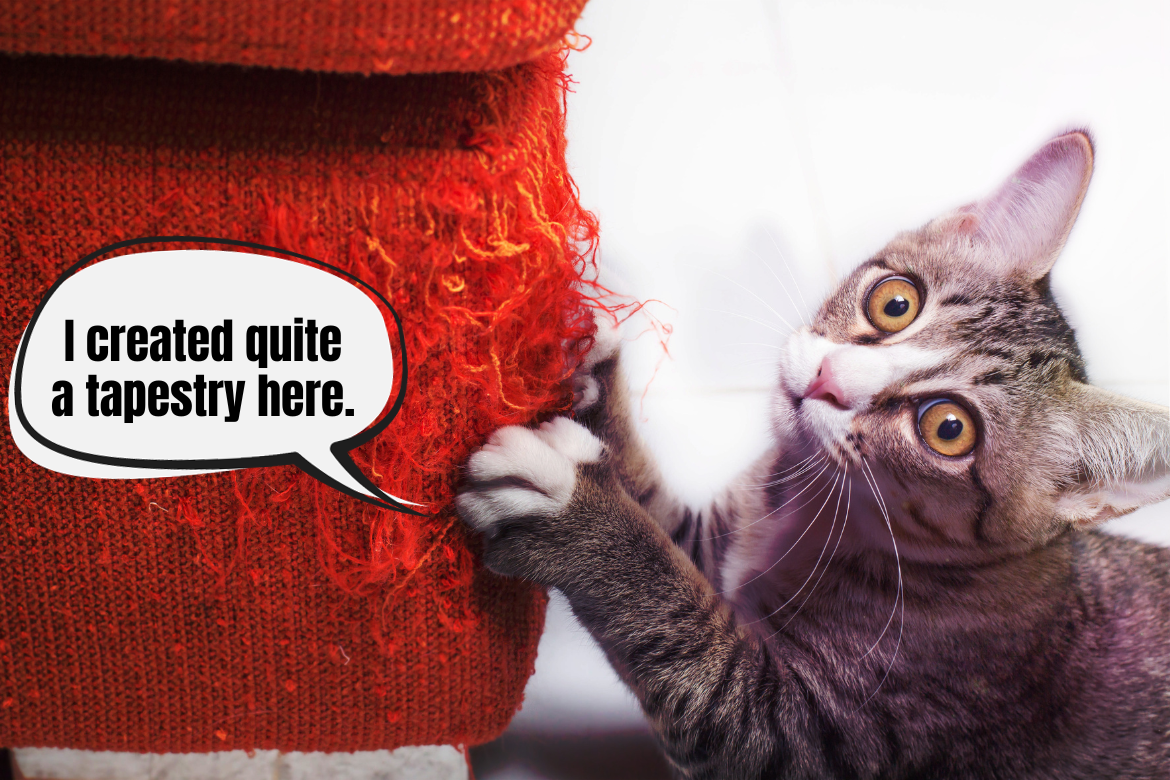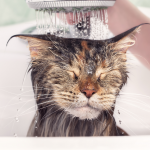Every fabCat knows that furballs are sweet cuddle buddies and uncontrollable mischief-makers enclosed in one fluffy body. And that’s why we love them! But when you enter a room, and the cat is tormenting the sofa instead of the scratching post… oh, there’s going to be a cat fight. Of course, we can’t change the feline nature—scratching is as important to them as eating or breathing! But what can we do, besides surrounding the house with scratching posts, to prevent sofas and chairs from looking like someone ran over them with a lawnmower? Today, fabCat, let’s explore whether cat-proof furniture exists and how to protect upholstery to withstand cat claws as long as possible.
Cat-proof furniture – is it even possible?
When a cat enters the home, the idea of replacing all the furniture with new ones doesn’t usually cross anyone’s mind. And rightly so, because by working with a cat from a young age, we can prepare the home space so that scratching the sofa and armchairs isn’t an enticing pastime for the cat. The dilemma arises when the cat actually scratches the furniture, and replacing the sofa becomes a necessity. What furniture should you choose so that the cat won’t shred it to pieces? Are there cat-proof pieces of furniture? And can we teach an old cat new tricks and redirect its attention from the sofa to the scratching post? Let’s find out.
Materials resistant to cat claws
Let’s start with cat-resistant upholstery. Surprisingly, fabCat, some materials are less interesting for cats and, at the same time, show fewer scratch marks. Generally, the best sofa for a fabCat Guardian is both durable and easy to clean in case of cat-related accidents or playful shenanigans. Materials that meet these criteria include:
- Microfiber and Microsuede: These are excellent materials if you want to limit scratches on chairs and sofas. Cats don’t necessarily enjoy sinking their claws into them because there’s not much to grip onto. Additionally, these fabrics are relatively resistant to stains and easy to clean, ensuring they stay in good condition even if your cat has an accident.
- Tightly Woven Fabrics: If you prefer a more classic upholstery, pay attention to the fabric’s weave density. The smaller and more tightly woven the loops are, the harder it is for a cat to embed its claws and create noticeable damage. Even if the cat occasionally scratches the sofa, the damage won’t be very visible, and you can easily hide it.
- Leather: Synthetic, eco-friendly leather is slightly less durable than top-grain leather, but if you opt for high quality, you can still count on cat-proof furniture. Leather is not entirely scratch-resistant, but minor, surface-level scratches look natural. Cats don’t necessarily enjoy scratching leather, although, of course, there can be exceptions.
- Outdoor Fabrics: You might think, outdoor furniture indoors? However, it’s a solid plan, fabCat, if your furballs tend to scratch sofas and chairs. Furniture designed for gardens or patios is usually among the most durable because the material it’s made from is adapted to withstand various weather conditions. If you have a cat that loves to cause chaos and mischief from morning to night, a sofa covered with outdoor fabric will be easy to clean and maintain, resistant to scratches, and comfortable enough for an evening movie session.
Looking at potentially cat-proof materials, you won’t find any tweed, corduroy, or velvet there. Although these materials may be visually appealing, they can be difficult to clean or not very resistant to scratches due to the type of weave. However, for velvet, you can find specially reinforced upholstery that allows you to indulge in a trendy sofa without worrying that the cat will destroy it.
How to protect the sofa from cat claws?
Choosing the material for the sofa or armchair is just the beginning. If you want your furniture to be genuinely protected in case of a feline attack, it’s worth reaching for additional tools. And we’re not talking about discouraging the cat from the sofa but rather protecting it so that the cat can fulfill its needs without wreaking havoc on your favorite chair.
Scratching post to the rescue. This issue probably doesn’t need reminding—a scratching post is a basic piece of furniture in every cat’s home. It’s best if it’s not a solitary one, hidden in the farthest corner of the apartment. Place scratchers where the cat truly needs to scratch, such as in the living room, next to the sofa, with a view of the window, or next to your workspace. Cats want to mark their presence where humans spend the most time. So, the sofa holds immense significance for them. A compelling scratcher placed nearby has a chance to divert the cat’s attention from the upholstery. With this thought in mind, scratchers like LUI, VIGO, and TOBI were created.
Check how to teach a cat not to scratch furniture with the help of scratchers: https://blog.mykotty.pl/en/2019/09/09/scratcher-vs-sofa-1-0-so-how-to-train-a-cat-not-to-scratch-the-furniture/
The sofa is off-limits. The sofa is a socially significant place, and when a cat is on it, they feel like part of your family. However, if you don’t want your cat to destroy the upholstery with their everyday shenanigans, consider protecting it. The simplest way is, of course, to throw a blanket over the sofa. It’s easy to wash or replace, and the cat might not want to scratch it (because the blanket lifts, so it doesn’t meet the stability condition necessary for every good scratching post). Some furniture also has the option to purchase an additional cover with which you can protect the entire sofa (including the sides). These are also easy to wash or replace if necessary.
“Double-Sided Tape” method. If you’ve ever searched the internet for proven ways to keep a cat from scratching the sofa, you’ve probably come across the “double-sided tape” method. It’s simply about covering the cat-scratched sides of the sofa with double-sided tape. Why does it work? Because when the cat sticks their paw to the tape once, twice, and repeatedly, there’s a good chance they will simply give up scratching in that area. Getting stuck on the couch is not enjoyable for the cat. However, for the method to have a chance of success, consistency is required, and the “YES-NO” method should be used, where for every forbidden action, you give the cat a more attractive alternative. Firstly, make sure the tape is always sticky and replace it regularly until the cat completely loses interest in the sofa and redirects their attention to the scratching post. Secondly, provide the cat with access to a scratching post right next to the sofa. It’s essential that it is sturdy, stable, and provides the same joy of scratching as the sofa— it shouldn’t slide or move under the cat’s weight; otherwise, the sofa will always be more attractive.
Cat pedicure. It’s not worth neglecting. Even if your cat isn’t particularly interested in scratching the sofa, it’s challenging to avoid pulling upholstery with claws as sharp as hooks. And remember—having an unlimited number of scratching posts at home doesn’t eliminate the need for trimming claws because cats sharpen them during scratching, rather than wear them down. Trimming just the sharpest tip will improve the quality of life for your cat, you, and your furniture.
Is it worth investing in cat-proof furniture?
We leave the answer to you, fabCat. In our opinion, it’s definitely something worth considering if your cats have taken on a life mission to change the sofa’s status and are tirelessly trying to turn it into a scratching post. However, the fact remains that no material will be 100% resistant to cat scratches. When you decide to take care of a cat, it’s good to work with them so that the sofa isn’t the only attractive place to scratch in the whole house. Because for a cat, scratching is as natural as breathing, eating, or using the litter box. It’s just an instinct that they need to satisfy. A feline way to strengthen their muscles, mark territory, keep up with personal hygiene, and play. And how about you, fabCats? How do you deal with furniture scratching? Does it happen to you consistently, or have you come across exceptionally well-behaved furballs? Let us know in the comments.



